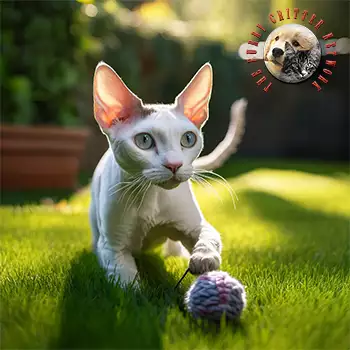Devon Rex cats excel in family environments, displaying exceptional patience and enthusiasm for children of all ages. Their playful, energetic nature aligns perfectly with active kids who appreciate interactive pets. These cats actively seek out children for games and attention rather than avoiding them. They tolerate enthusiastic handling remarkably well, rarely reacting with aggression even when play becomes somewhat rough. Their sturdy build despite delicate appearance withstands active play without injury.
Many Devon Rex form special bonds with children, becoming devoted companions who participate in playtime, sleep in kids' rooms, and provide comfort. They appreciate the attention and activity children offer, finding kindred spirits in energetic youngsters. Their patient temperament makes them suitable for families with young children, though supervision ensures positive interactions. Even toddlers can coexist successfully with Devon Rex when adults monitor contact.
Teaching children appropriate cat interaction enhances relationships. Kids should learn gentle handling, recognizing when the cat wants engagement versus rest, and respecting boundaries. Show children how to pet softly, play appropriately with toys rather than hands, and allow the cat to approach them. While Devon Rex tolerate more than many breeds, all cats deserve respectful treatment. Explaining that the cat has feelings and preferences helps children develop empathy.
Providing escape routes gives cats options when needing breaks from activity. Despite their tolerance, Devon Rex benefit from accessible retreat spaces. Cat trees, high shelves, or designated quiet areas offer sanctuary. Teaching children to respect these spaces prevents stress. Most Devon Rex use retreats minimally, preferring to remain with family even during noisy activities, but having options prevents stress.
Integration with other cats typically succeeds easily due to Devon Rex social nature. These cats genuinely enjoy feline companionship, often forming close friendships that include mutual grooming, playing, and sleeping together. They adapt to resident cats when introduced properly, showing friendliness rather than territoriality. Their playful energy may overwhelm elderly or sedentary cats initially, but most households establish harmony with time.
Gradual introductions over several weeks allow cats to adjust comfortably. Begin with scent swapping by exchanging bedding between cats. Progress to visual contact through baby gates or cracked doors without physical interaction. Finally, conduct supervised meetings in neutral territory. Provide separate resources initially including food, water, and litter boxes. Most Devon Rex integrate smoothly, eager for companionship rather than competition. Their lack of aggression and genuine interest in friendship facilitate peaceful multi-cat households.
Compatibility with dogs often surprises those expecting typical feline aloofness. Devon Rex display confident, dog-like personalities that mesh well with canine companions. They don't automatically fear dogs, instead approaching with curiosity and playfulness. Many form devoted bonds with family dogs, playing chase games, sleeping together, and genuinely enjoying each other's company. Success depends partly on dog temperament, with cat-friendly, gentle breeds working best.
Introduce dogs and cats carefully with controlled initial meetings. Keep dogs leashed during early interactions, allowing the cat to approach at their own pace. Reward calm behavior from both animals. Supervise all interactions until confident in their friendship. Most Devon Rex adapt quickly to dogs, particularly when introduced as kittens. Their social nature and desire for companionship make multi-species households successful, creating harmonious homes where Devon Rex thrive surrounded by humans and animals who appreciate their affectionate, playful, mischievous nature.

